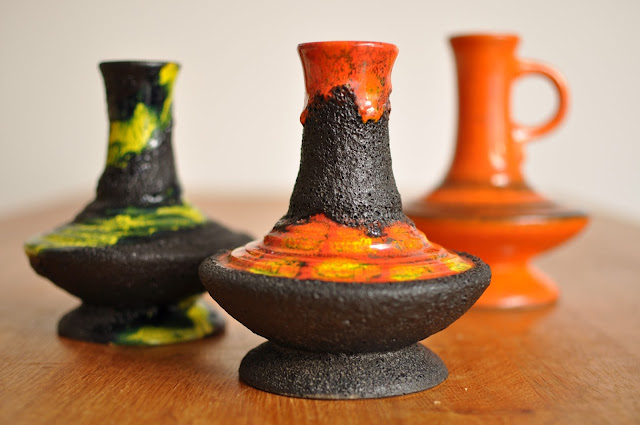A lot of mystery
still surrounds this maker, and our knowledge is definitely fragmentary. They
were first thought to be called Söndgen, later Kera Keramik, but we only
recently found out that the company was actually called Walter Gerhards KG, and they were
located at the epicenter of the German ceramics industry in Ransbach -
Baumbach, located in the famous Westerwald area. The company was probably led
by Mr. Walter Gerhards himself, as he is listed as the liable person for the
company in the companies registry (Handelsregister). They existed only for a
short period of time: from 1959 until January 25, 1978, when it was
deregistered. During this period the factory apparently produced items under
the names "WG Kera Modern" and "WG Exquisite Kera Modern"
from 1959 until 1974, and from 1974 until 1978 under the name
"Gerhards" and "Gerhards Gmbh". Labels on these vases seem
relatively rare, but most vases are marked in a specific way, that can help us
recognize them.
Because the company
only existed for 19 years, this would logically mean that the output from
Walter Gerhards KG is much smaller, and thus rarer, than the output from large
and long existing companies like Scheurich or Ruscha.
So why do I love the
vases that were made by Walter Gerhards? The ranges produced have strong
shapes, that for me are characteristic for the Mid Century Modern period,
mostly with sharp angles combined with curved lines. Some shapes are unlike anything any other
company ever made, and they are very innovative.
One of my favorite
shapes is the 1040, or as we like to call it in our family: the 'UFO vase'. I
can imagine that the design of the vase was inspired by the space race of the
1950s and 1960s - or by the interest in extraterrestrial life, as was not uncommon
in design of this era.
 |
| "Look! A flying Walter Gerhards vase!" |
For me this design
is the perfect example of a combination of strong straight lines with curvy
lines, something West-German pottery is renowned for. This vase comes in
several glazes, so far I have 5 and a few small variations, but my favorite is
the version that comes with thick black lava and is combined with a beautiful
red/yellow/orange glaze, as pictured below.
As you can see,
these wonderful outlandish shapes were combined with some of the most beautiful
glazes. Walter Gerhards uses daring color combinations such as bright green on
black, purple with yellow, and orange with black. For me these colors ooze the seventies.
In addition to colors, a lot of attention in the design is paid to using
different textures. Thick lava drippings are combined with extremely glossy
glazes, and matte backgrounds are mixed with shiny glazes.
Another important
aspect for me is the high quality of these vases. The vases are quite heavy and
the glazes seem expensive. They look more like studio vases than mass-produced
vases, but I'm not sure if that is true. Unlike some companies, I have never seen
a Walter Gerhards vase with a production error or with unglazed areas. All in
all, they are just nice to handle, to touch!
In my opinion Walter
Gerhards is still very much underrated by West-Germany collectors, and maybe
this is because the output of the factory seems small and so little information
is yet known about the company. Hopefully we will find out some more information
about Walter Gerhards and his company in the future. I would definitely
recommend picking up some pieces now, as bargains can still be found, if only because they make a wonderful
addition to the collection of any Fat Lava lover!
 |
| High quality glazes and beautiful shapes |
Do you have any wonderful examples of Walter Gerhards pottery, or new glazes on the 1040 that you want to share! Let me know in the comments section, I would love to see them!
A lot of theinformation used on this blog was shared by members on the amazing pottery & glass forum. If you love West-German pottery and have never visited the site, please go and have a look! www.potteryandglass.forumandco.com


No comments:
Post a Comment